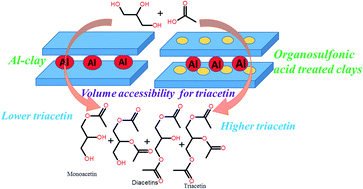Volume accessibility of acid sites in modified montmorillonite and triacetin selectivity in acetylation of glycerol
Abstract
Organic acid treatment enhances the acidity and surface characteristics of montmorillonite clay by dealumination. Dealuminated and Al-clays were used for acetylation of glycerol with acetic acid. All clays used had comparable acidity but pore characteristics were different. Though glycerol conversions were similar but triacetin selectivity was different. Al-clay and acid treated clays showed poor and improved selectivity, respectively. This was attributed to increased pore volume around the acid sites, which facilitates the multiple acetylation of glycerol. The generated space around acid centers, termed as ‘volume accessibility’, helps glycerol to interact with acylium ions formed on the acid sites more effectively leading to formation of triacetin. Correlations were made between the changed characteristics of clays and triacetin yield. Among the different correlations, triacetin selectivity correlates well with the volume accessibility. The latter is quite useful in predicting the catalytic performance.


 Please wait while we load your content...
Please wait while we load your content...